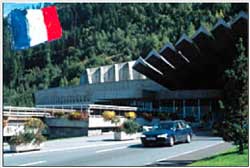ALERT in the Mont Blanc tunnel
Since its opening in 1965, the Mont Blanc tunnel has linked together the Haute Savoie and the Valle d'Aosta. As an essential tie between France and Italia, the tunnel has been, since more than 35 years, a strong driving force behind the local economic development.
The fire that occurred on March, 24th 1999 caused very important damage and most importantly 39 people killed. It led to a 3 year closure of the tunnel and obliged the concerned authorities to completely rethink and reorganize its conception.
The Mont Blanc tunnel

The fire that occurred on March, 24th 1999 caused very important damage and most importantly 39 people killed. It led to a 3 year closure of the tunnel and obliged the concerned authorities to completely rethink and reorganize its conception.
Since its reopening on March 9th, 2002, the tunnel management has been conceded to a unique structure, the TMB GEIE (European Economic Interest Group), subsidiary of the two concession companies: ATMB (Autoroute et Tunnel du Mont Blanc), a semi-public company held at 56% by the French state and SITMB (Societa Italiana del Traforo del Monte Bianco).
The new operation configuration
Security being the essential prior condition to the tunnel reopening, everything has been rethought to respond to this absolute imperative.

The most enhanced systems have been chosen:
- Automatic detection of incident by analysis of video images (120 cameras)
- Thermographical detection of fire at the tunnel entrance and all along the tunnel
- Smoke detection by opacimeter
- Anti-fire network supplied by 4 water tanks
- Reinforced system for ventilation and smoke extraction system (150 m3/sec on 600 meters)
- Dynamic road signs (variable message sign, emergency lights, barriers with flashing lights, broadcast of messages on FM radio).
All the equipments are controlled by a computerized data acquisition and processing tool, the Tunnel Management System (TMS) which integrates several enhanced tools for decision assistance.
This system continuously controls and supervises all the tunnel facilities and monitors the traffic flow (number and type of vehicles, speed, inter-distances). It detects all abnormal situation and immediately informs the operator. In case of incident, it proposes a scenario related to the nature of the incident. This scenario automatically initiates the appropriate actions : selection of the suited road sign configuration, adaptation of the ventilation, user information (radios FM, variable message signs), rescue alert and communication with external participants.

The Tunnel Management System is distributed on two Tunnel Control Centers located at each end of the tunnel. Each control center includes 2 workstations with 4 screens and a 7 meter long synoptic screen.
The Tunnel Management System is based on a InfoPlus.21 architecture (real time database) that includes 4 redundant servers. The data acquisition and the control of equipments are performed through an OPC (Ole for Process Control) client interface.
Alert Implementation
The Alert Software has been integrated in the Tunnel Management System to assist the operators with calling up of the emergency assistance services and information broadcasting.
Alert is installed in redundant mode on each command station and is directly driven by the IP21 software through its OPC server interface for the call commands and the control of the call progression. The calls transmitted by Alert are of 2 types:
- Telephonic call of on duty operators (road assistance, electricians, technicians, computing assistance, ), or operators of the technical departments or administrative services. The called operators are automatically connected with the control center that have originated the call.
- Transmission of fax to various administrative services or organizations (motorway companies, police station, equipment, ) when incidents occurred in order to supply all the necessary information about the context and history of the incident.
A new functionality has been implemented in Alert for this occasion: the automatic call forwarding to a designated telephonic number. This functionality allows Alert to be used for the maximum simplification of the call operations of a user by taking in charge the following tasks:
- Automatic selection of the operator (according to the on-call schedule of the group to be called).
- Call transmission.
- Validation of the communication (identification of the called user).
- Resumption of the call in case of failure, to the same number or a relief number.
When the communication is established, the call is automatically forwarded to the originated calling station.
|